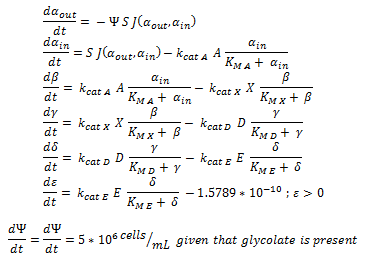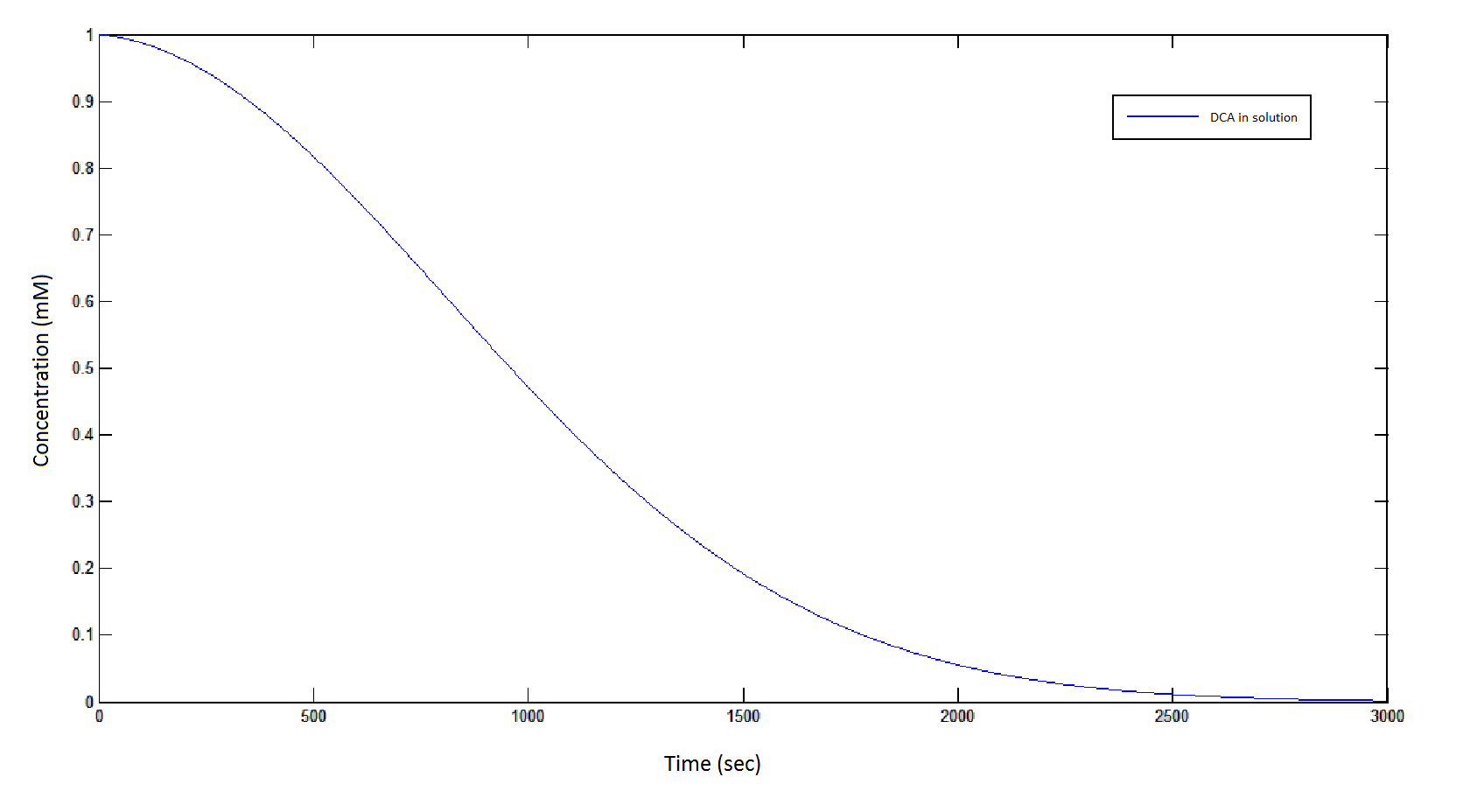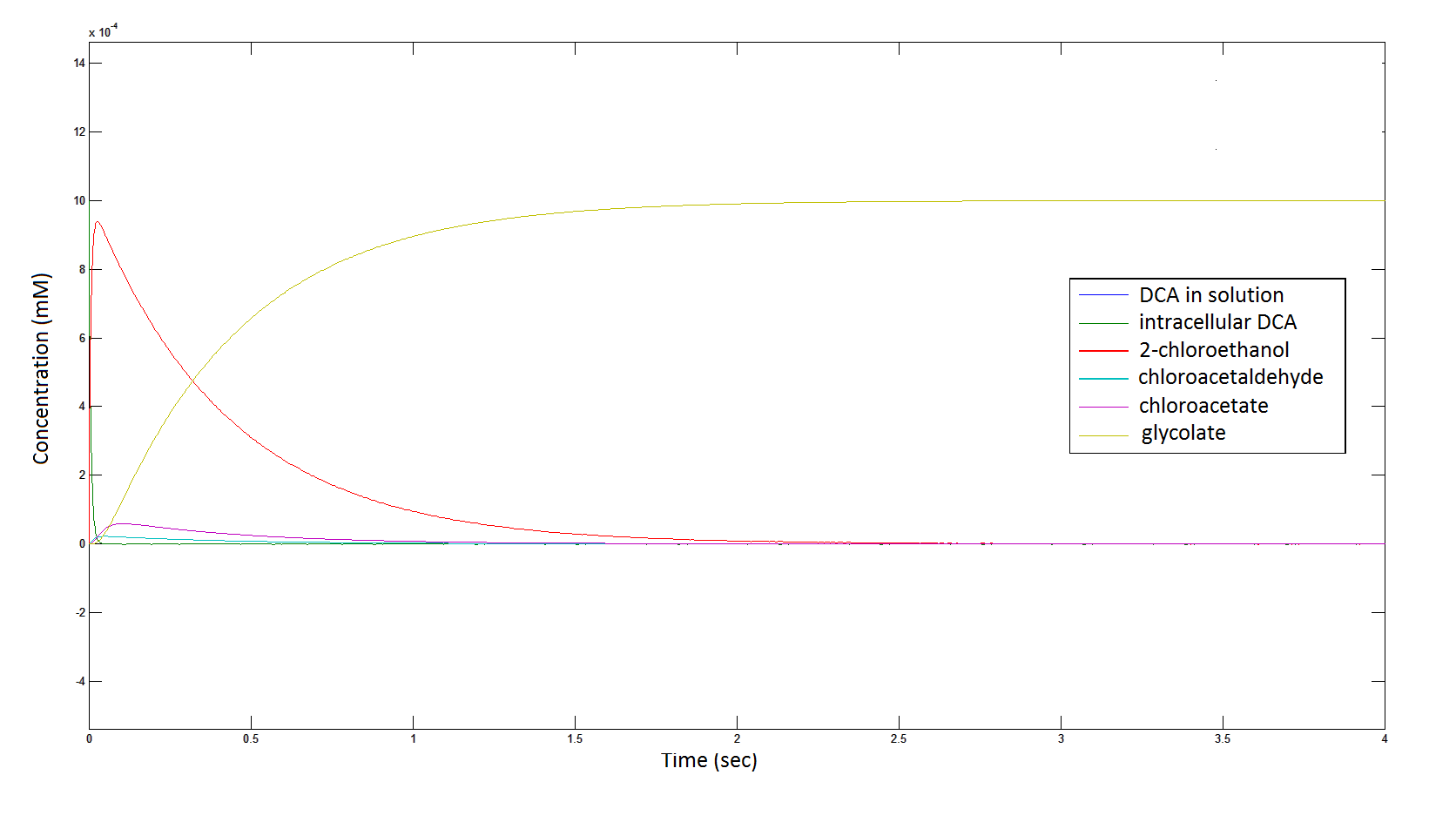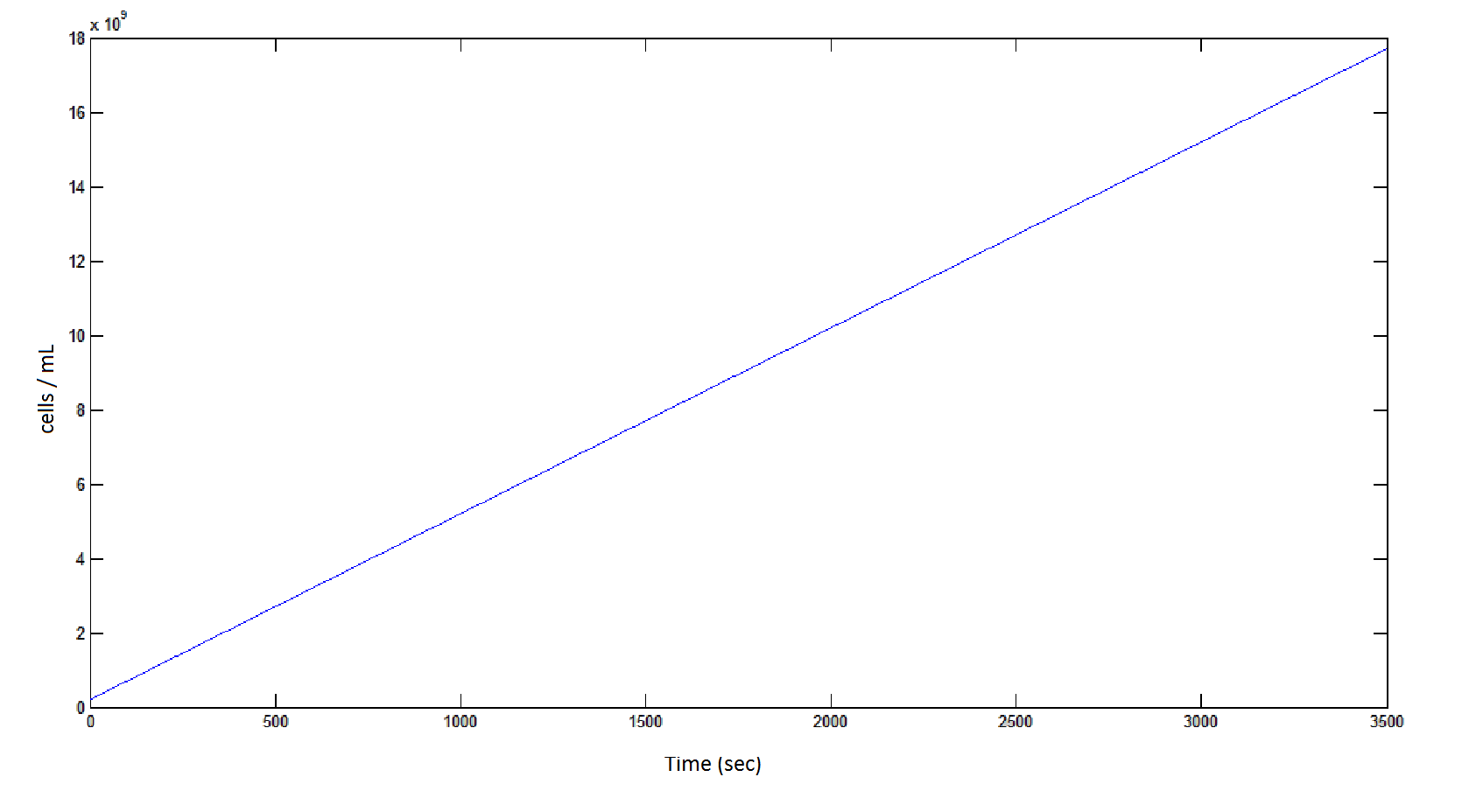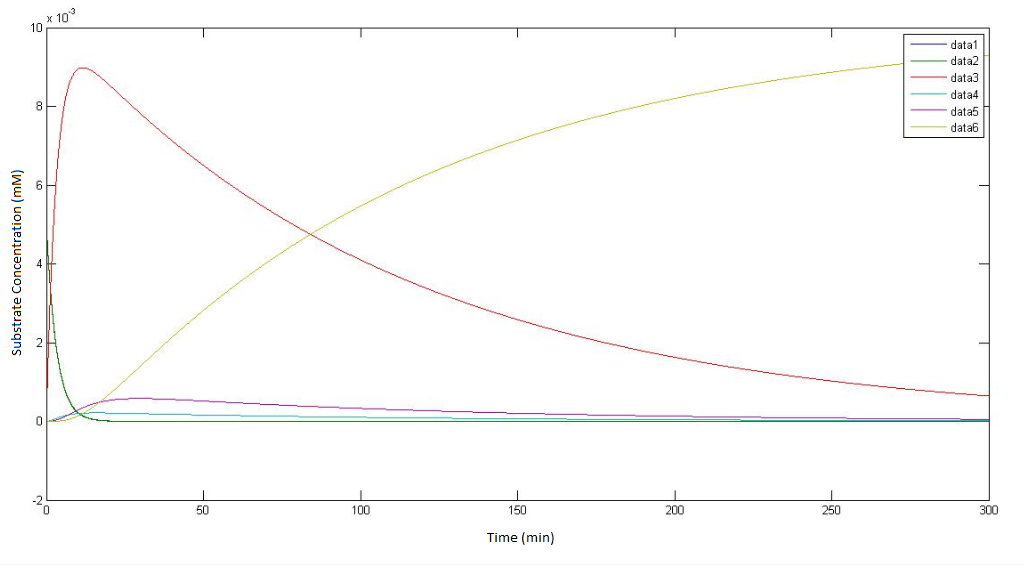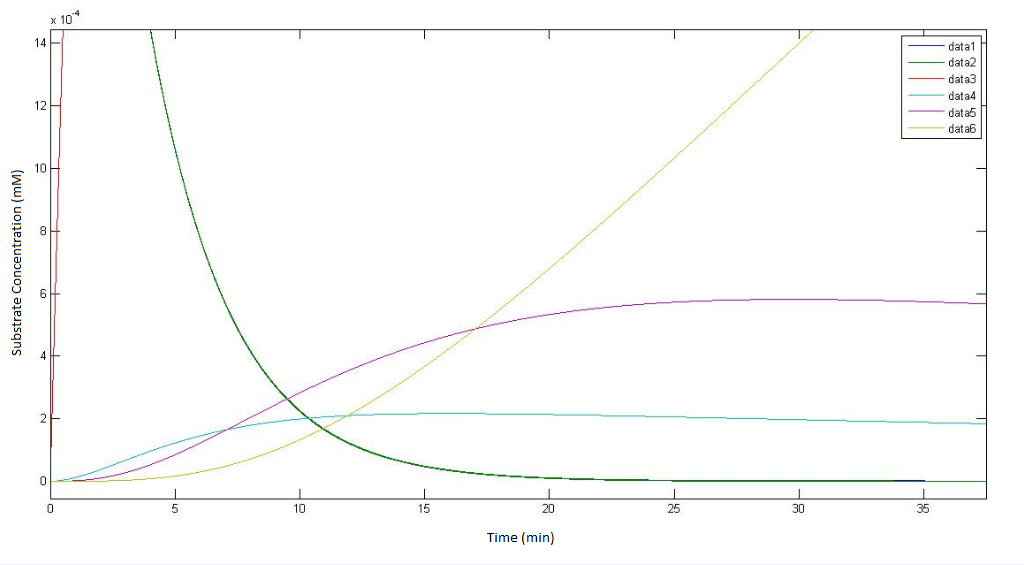Team:SydneyUni Australia/Modelling Results
From 2013.igem.org
| Line 63: | Line 63: | ||
'''The rate at which DCA is removed in solution:''' | '''The rate at which DCA is removed in solution:''' | ||
| - | [[File:DCAcominin.png|950px]] | + | [[File: DCAcominin.png|950px]] |
Graph 1: The blue line represents how the concentration of DCA in solution decreases due to the action of our DCA degraders. The red line represents the intracellular concentions of the metabolites (disregard in this graph). One can see that an initial concentration of 2E8 cells/mL completely removes the DCA with a concentration 1mM in (roughly) 150mins. | Graph 1: The blue line represents how the concentration of DCA in solution decreases due to the action of our DCA degraders. The red line represents the intracellular concentions of the metabolites (disregard in this graph). One can see that an initial concentration of 2E8 cells/mL completely removes the DCA with a concentration 1mM in (roughly) 150mins. | ||
| Line 69: | Line 69: | ||
'''The Rate at which the intracellular concentration of the metabolites change over time:''' | '''The Rate at which the intracellular concentration of the metabolites change over time:''' | ||
| - | [[File: | + | [[File: intermediates1111.png|950px]] |
Graph 2: Each line represents the concentration of each of the metabolites . This graph is simply a rescaling of graph 1. Note: the glycolate won’t accumulate in the cell – it is metabolised – the model had glycolate as the final product. It is used to show that the presence of glycolate can attribute to cell growth. | Graph 2: Each line represents the concentration of each of the metabolites . This graph is simply a rescaling of graph 1. Note: the glycolate won’t accumulate in the cell – it is metabolised – the model had glycolate as the final product. It is used to show that the presence of glycolate can attribute to cell growth. | ||
Revision as of 09:37, 23 October 2013


Running the Model
The modelling for both the pathays had initial conditions of:
table
and using the constants above the flux, J, took the value:
The Non-monooxygenase Pathway
ODE overview:
Raw MATLAB code:
function dy = nop450(t,y)
dy=zeros(7,1);
dy(1)= -y(7)*(6*10^(-12))*0.0463067*(y(1)-y(2));
dy(2)= ((6*10^(-12))*0.0463067*(y(1)-y(2)))-3.3*25.55*(y(2)/(0.53+y(2)));
dy(3)= 3.3*25.55*(y(2)/(0.53+y(2)))-0.0871*25.55*(y(3)/(0.94+y(3)));
dy(4)= .0871*25.55*(y(3)/(0.94+y(3)))- 0.6*25.55*(y(4)/(0.16+y(4)));
dy(5)= 0.6*25.55*(y(4)/(0.16+y(4))) - 25.4*25.55*(y(5)/(20+y(5)));
if y(6) > 2*10^(-10)
dy(6)= 25.4*25.55*(y(5)/(20+y(5))) -1.5789*10^(-10)
else
dy(6) = 25.4*25.55*(y(5)/(20+y(5)))
end
if y(6) > 0.0005
if y(7) > 1.6E11
dy(7)=0
else
dy(7) = 5*10^6
end
else
dy(7) = 0
end
end
MATLAB output:
The rate at which DCA is removed in solution:
Graph 1: The blue line represents how the concentration of DCA in solution decreases due to the action of our DCA degraders. The red line represents the intracellular concentions of the metabolites (disregard in this graph). One can see that an initial concentration of 2E8 cells/mL completely removes the DCA with a concentration 1mM in (roughly) 150mins.
The Rate at which the intracellular concentration of the metabolites change over time:
Graph 2: Each line represents the concentration of each of the metabolites . This graph is simply a rescaling of graph 1. Note: the glycolate won’t accumulate in the cell – it is metabolised – the model had glycolate as the final product. It is used to show that the presence of glycolate can attribute to cell growth.
Rescaling the graph once again: the rate at which the metabolic intermediate change over time.
Graph 3: Each line represents the concentration of each of the metabolites . This graph is simply a rescaling of graph 1 and 2.
The rate at which the cells grow over time:
Graph 4: the blue line represents the linear increase of cells due to the presence of intracellular glycolate.
Raw MATLAB code for the pathway not involving p450
function dy = p450(t,y) dy=zeros(5,1); dy(1)= -6*(10^12)*0.0463067*(y(1)-y(2)); dy(2)= 6*(10^12)*0.0463067*(y(1)-y(2))-89.8*0.1*(y(2)/(7.2+y(2))); dy(3)= 89.8*0.1*(y(2)/(7.2+y(2)))-0.6*0.1*(y(3)/(0.16+y(3))); dy(4)= 0.6*0.1*(y(3)/(0.16+y(3))) - 25.4*0.1*(y(4)/(20+y(4))); dy(5)= 25.4*0.1*(y(4)/(20+y(4))); end
Raw MATLAB code for the pathway involving p450
Output:
The output of the raw MATLAB code for the pathway not involving p450 which depict how the concentrations of each metabolite change over time. The 't=0 min' time point is the point where the engineered cells are instantaneously introduced (and evenly homogenised) to a solution of DCA with an initial concentratioN OF 0.1Mm.
Regarding the figure legends with in the graphs themselves data 1, data 2, data 3, data 4, data 5 * data 6, represents the concentration of the metabolites αin, αout, β, γ, δ & ε respectively. The bottom graph is a rescaled version of the top graph so as to achieve a higher resolution the dynamics of the metabolites.
References:
[1] Krooshof, G. H., I. S. Ridder, et al. (1998). "Kinetic Analysis and X-ray Structure of Haloalkane Dehalogenase with a Modified Halide-Binding Site†." Biochemistry 37(43): 15013-15023.
[2] Janecki, D. J., K. G. Bemis, et al. (2007). "A multiple reaction monitoring method for absolute quantification of the human liver alcohol dehydrogenase ADH1C1 isoenzyme." Analytical Biochemistry 369(1): 18-26.
[3] Pandey, A. V. and C. E. Flück (2013). "NADPH P450 oxidoreductase: Structure, function, and pathology of diseases." Pharmacology & Therapeutics 138(2): 229-254.
[4] van der Ploeg, J., Shmidt, M. P., Landa, A. S., and Janssen, D. B. (1994). "Identification of Chloroacetaldehyde Dehydrogenase Involved in 1,2-Dichloroethane Degradation." Applied Environmental Microbiology (60(5): 1699-1605.
[5] van der Ploeg, J., van Hall, G., Janssen, D. B. (1991) "Characterization of the haloacid dehalogenase from Xanthobacter autotrophicus GJ10 and sequencing of the dhlB gene." Journal of Bacteriology 173(24):7925-33.
[6] Sinensky, Mi “Homeoviscous Adaption – A Homeostatic Process that Regulates the Viscosity of Membrane Lipids in Escheria coli” Proceedings from the National Academy of Science 71(2): 522-525.
[7] CyberCell Database
 "
"
